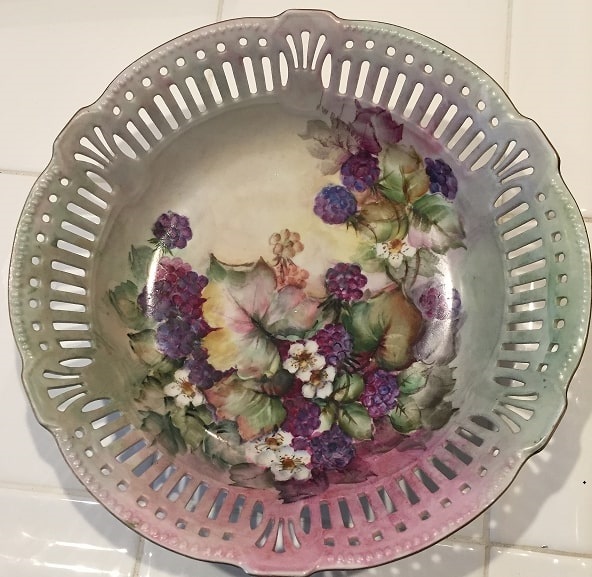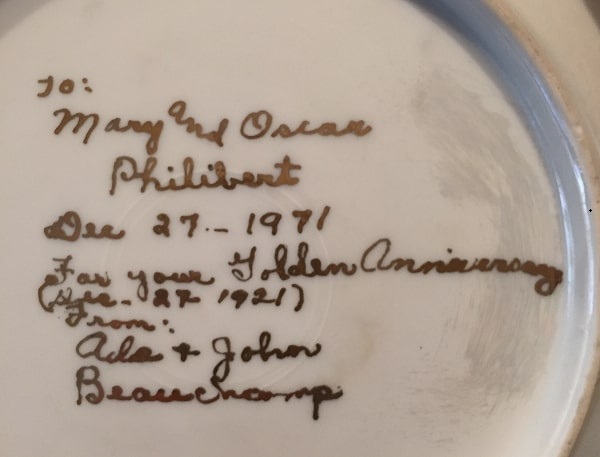Introduction: In this article – in honor of Mother’s Day – Gena Philibert-Ortega writes about documenting and caring for family heirlooms inherited from your mother. Gena is a genealogist and author of the book “From the Family Kitchen.”
Genealogy is much more than searching for paper documents that list facts about our ancestors’ lives. In addition to the documents we search for and gather, once you are known as the family historian, you may inherit various family heirlooms or “stuff” as well.
Your home archive might include items inherited from female ancestors, from your own mom back multiple generations. This stuff can span the everyday to things she was gifted or used on special occasions. Items may hold special memories of how or when they were used, or might just serve as a reminder of a story of her life.
I was given my great-grandmother’s hand-painted china bowl.

What’s special about that piece is that it includes information about her 50th wedding anniversary.

What have you inherited from your mom? Your home may include the following items (or more):
- Clothing
- Jewelry
- China
- Silver
- Linens
- Quilts
- Cookbooks
- Recipe cards
- Aprons
- Kitchen tools
- Furniture
- Books
- Correspondence
- Diaries/Birthday books/Scrapbooks
- Photographs
- Collectibles
If you’re like me, you may own items that are typical heirlooms (such as jewelry and china) combined with other items that are unique (I have a bar of soap my maternal grandmother made, and my paternal grandmother’s 5th grade math book). What are you doing to make sure the stories of those items get documented, and to ensure the future of the items?
Provenance
I think one of the things we as genealogists probably don’t concentrate on enough is preserving and documenting heirlooms. You can find information online for how to safely store the items, which is important, but you also need to document the items for future generations.
Documentation is imperative so that future generations know what the item is, whose it was, and its importance. One of my sons recently said “I don’t know what is important and what isn’t” when discussing my collection of family history. He’s right. And he needs to know that now while I’m alive so that he can make decisions about these items in the future.
You could create your own documentation form depending on the item, and include answers to questions such as:
- Date
- What is this item? (Description)
- Where is it currently stored?
- What is it made from?
- When was it made?
- Who originally owned it?
- How is it used? Does it have instructions?
- If it is handmade, who made it?
- What significance does it have for our family?
- What stories are there about this item?
- Why should it be kept in the family?
- Who should be contacted about keeping this item?
- How should this item be cared for or stored?
Don’t forget to also add photographs so that the item is easily recognized. Obviously, depending on the type of item, there might be more detail added. In the case of a quilt or textile, you may provide the size and more details about its construction. Your family won’t know the familial value of an heirloom (or maybe what an heirloom is versus other antiques you collect) if you don’t provide this information.
Take Care of the Future
So now that your item is documented, how do you preserve it for the future? Well, it depends on what it is, but in general your heirlooms like what we like: no direct sunlight, no bugs, a comfortable temperature, and stored in the home but not in the attic or garage. Each item will have its own challenges in terms of preservation and storage. Items made of paper can deteriorate because of the acids in the paper. How you preserve those items is going to be different than an item made of metal.
There are various places online to learn more about preserving the items that genealogists inherit. The Library of Congress Collections Care web page is a good place to begin. Genealogists Melissa Barker and Denise Levenick both have great posts on preserving various family heirlooms on their respective websites A Genealogist in the Archives and The Family Curator. You can also consult online sources for books that focus on the care and storage of particular types of heirlooms or collectibles.
Preserve All Parts of Her Life
Genealogy is much more than facts printed on paper. It’s the images we collect, the heirlooms we inherit, and the material items that remind us of family. Documenting and preserving those items are a part of our family history work.
Happy Mother’s Day!

On my father’s side of the family, I inherited many things from my great-grandmother Cloutier and her sister, Anne E. Thing: a roller piano, grandfather clock, lace sewn together by her in a patch work type of way to fit a small table (she made two) from lace hand-made for a wedding dress, cuffs of dresses, bibs of dresses, and different parts of dresses. I have not yet compared her picture where she’s wearing a lace dress to see if that lace is in the cloth; it could have been her wedding dress. Also: dishes, a table, a shipping trunk, a comb with rhinestones, oh and lace that surrounds two pillow cases. I’m not sure, but I think this lace was made for that. My grandmother gave me this when I got married in 1966, so my mother sewed it on the pillow cases in 2013. It had been in a box stored all this time. All the items are in storage right now, except for the lace table cloth and lace pillow cases, and hair comb. I also inherited an oak dresser, made by my great uncle on my mother’s side of the family.
Terralea, it sounds as though you’ve inherited some wonderful heirlooms. What a treasure! I hope you’ll take some time to document them and write out the story of those items.
Thanks for taking the time to share them with us.
Thank you for this article.
Since I was very young, I have been rescuing and researching family ítems (letters, wedding cards, photos, etc.). I used to spend the afternoon reviewing them with my grandma (1895-1996), writing down names and recording childish interviews.
Now, so many years after, while I play those tapes, or review those amateur provenance notes, I close my eyes and cherish those moments.
We can only wish that someone down the road feels the same, and sees these heirlooms not just as a quick cash opportunity, garage sale material, or stuff that the aunt hoarded…
Grace, what a wonderful memory. Thank you for sharing that.
I found this article very interesting, because I too have collected many things over the years. Honestly, I never thought too much about them until recently. My youngest grandson, who’s now ten, spends a lot of time with me and enjoys talking with me. Much more than any of the other four. I have a chair, which I’ve been trying to find out about for over two years, but really trying the past six months. When I was twelve, I inherited the Old Man chair, as he’s called, from my Uncle Sonny. He’s the youngest of nine children, my father’s youngest brother and only living relative of those children. The chair was carved by my father’s great or great great uncle, named John. He fought in the Civil War and carved two canes depicting the war, and this chair in his likeness. He supposedly had a leg injury but I haven’t confirmed that just yet. It turns out there were two John Cain’s that fought in the CW, but I haven’t been able to confirm all the information yet. My hope is that I can, and that my grandchildren will know about him one day. I was so young and didn’t really care, but now I’ve become obsessed with finding out! My parents donated the two canes, and I’m trying to locate them, as I don’t remember where at. One things for certain, I’ve learned more about my family this past six months than I ever dreamed about knowing. Some things I’ve discovered have caused some hard feelings and upset some of my siblings and others, but I expected they were not without stories that went untold. I’m very close, I believe, to finally finding the correct man who made my chair and I’m delighted knowing all that I’ve found! Thank you for giving me some hope.
There is definitely hope Denise! I’d love to hear what you find out about the Old Man chair. Your grandchildren will also want to know about that. Even those that aren’t interested now, will be one day.
I inherited from my grandmother, Carrie Narcissus Long Fidler, a wardrobe made from cedar wood in Mecklenburg County, North Carolina. She paid her reform Presbyterian Minister in like wood for his labor.
What a great story Carolyn! Thanks for sharing that with us.